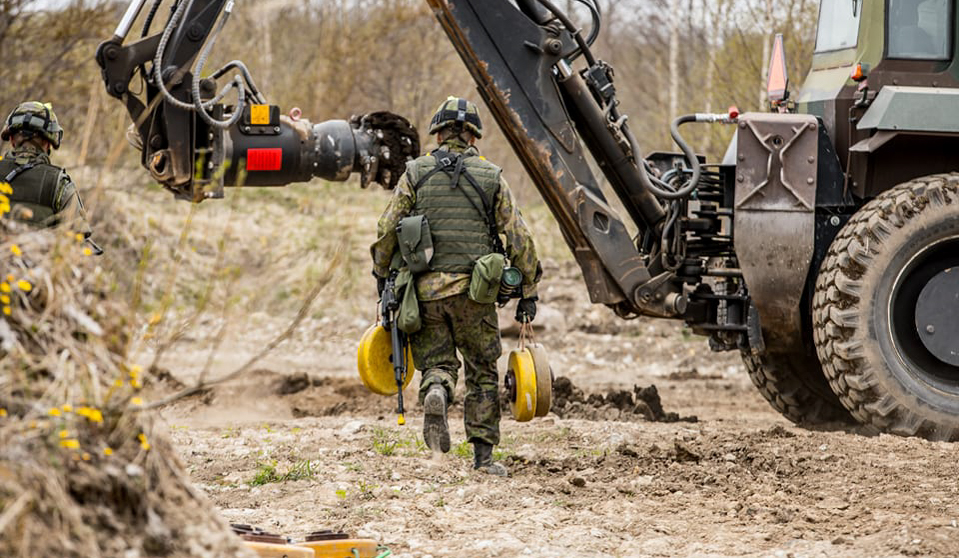The 100-Year Old Engineer Branch Advances with the Times

Finnish engineers have supported the fight of the other branches, mainly the infantry, for a hundred years. In a century, Finland has become one of the foremost experts in counter mobility, and a versatile professional in the field of mobility, fortification and camouflage and CBRN. Finnish military engineering skills are internationally high level and recognised.
The anniversary of the Finnish engineers is celebrated on 25 July in honour of the victorious Battle of Schmarden. We have come a long way since the founding of the branch. Our military operating environment has changed. This also sets challenges for engineers: a modern military engineer must be able to create counter mobility obstacles and fortify positions faster on today’s battlefield. Additionally, we must have the ability to facilitate the mobility of the striking forces in the immediate effect area of the fighting. Previously the time frame for the preparations was calculated in months, today it is days. Lately we have particularly focussed on developing our combat readiness and situational awareness, that also plays a big part in combat readiness. We now have a good understanding of what we can do in emergency conditions.
Currently, Finland is top of the world when it comes to counter mobility. We have the most mines and military engineers compared to other European countries. We can be proud of our counter-mobility skills. Continuous awareness of combat capability is central to success. Improving combat capability must be correctly timed so that the benefit is maximized. Everyone’s effort is needed in developing our branch. Making mistakes is also allowed – as long as you learn from them. Our training should above all else produce combat effective infantry soldiers who are also experts in engineer and CBRN tasks. It's a question of attitude. The international cooperation of the branch will be developed to a level that provides engineer branch personnel with the skills and competence needed for operating in the increasingly international operating environment also in the future. The equipment and kit at our disposal will be kept in working condition.
Engineer training and capability are systematically developed. We have written an extensive development plan for 2018-202. The plan creates guidelines for developing the branch until 2028 and a basis for development from 2028 onward. Systematic development is a basic requirement for continuity in the quickly changing operating environment that we live in.
A significant reform in training is starting engineer training in the Jaeger Brigade in 2019 and in the Guard Jaeger Regiment in 2020.
The end state of the development phase is that the engineer branch is able to support the mobility of the reserve in the immediate effect area of the fighting. We are able to start executing the most essential engineer activities within days. Important targets have already been fortified during normal conditions with heavier materials, such as concrete. CBRN capabilities enable advance warning, adequate protection against CBRN agents and decontamination of forces exposed to CBRN agents.
In terms of development we must particularly look to doing things in a coordinated manner. New operating procedures and equipment will be taken into use at the right time and not everything at the same time.
We are developing the different areas of military engineering as follows:
- Mobility: We are improving the mobility capabilities of our mechanised forces in the combat zone and modernize the capability of our EOD companies.
- Counter-mobility: we can begin counter-mobility operations even faster at the first locations. We are looking at the possibilities for using remotely controlled mines.
- CBRNe defence: We will develop our reconnaissance, decontamination and rescue capabilities and improve the protective equipment of an individual soldier.
- Fortification and camouflage: we will improve our ability to fortify structure quickly.
- Command and Control: we will mainly use electronic systems for engineer information management.
Engineers are International
The goal of international activities is to develop the Defence Forces’ readiness do provide and receive international assistance and to increase international connectivity. Finnish military engineers have participated in multiple crisis management and peacekeeping operations around the world. We actively train with our international partners both in Finland and abroad. Our standard operating procedures and methods follow international development and trends. We also train foreign engineers in Finland and host annual training courses in military engineering and CBRN.
Other countries are also interested in our high level competence in counter-mobility. We organise annual information exchange meetings for those countries. We work very closely together with Sweden both in terms of training and materiel procurement. Our personnel regularly participate on courses and training events hosted by the EU, NATO and our other partners. You could say that the international cooperation and spirit of the engineers that started over a hundred years ago has not waned.
Inspector of Engineers, Colonel Matti Lampinen
The engineers as a branch
- Engineers slow down and channel the movement of the enemy and cause him casualties by building counter-mobility obstacles, which consist of mine fields and various types of barriers (bridge and road demolitions, abatis and earthworks).
- To aid the mobility of friendly troops in the immediate effect area of the fighting, engineers clear mines, maintain the roads in good condition and, when needed, build bridges and roads that are suitable for field conditions. Pontoon and bridge equipment can also be used to cross waterways.
- The objective of CBRNe training is to provide combatants with readiness to survive when within the sphere of influence of chemical, biological, nuclear and incendiary weapons.
- Engineer conscripts are trained in the Army and Navy brigade-level units (equiv.). There they will receive high level combat training and versatile and interesting training for engineer branch skills.
- The engineer branch anniversary is celebrated on 25 July 1916 in honour of the battle of Schmarden. A specific anniversary date for establishing the engineer branch within the Finnish Defence Forces has not been named.



